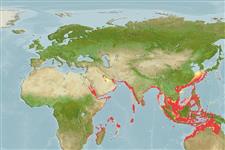Environment: milieu / climate zone / depth range / distribution range
Ecologie
marien demersaal; diepte 20 - 240 m (Ref. 89707). Tropical; 33°N - 23°S, 35°W - 143°E (Ref. 5222)
Indo-West Pacific: Red Sea, Persian Gulf, Gulf of Oman, Pakistan, India, Viet Nam, Hong Kong, China, Korea, southern Japan, Taiwan, and northwest Australia. Unknown from the east coast of Africa, islands of the Indian Ocean, Indonesia, Philippines, or New Guinea.
Lengte bij maturiteit / Grootte / Gewicht / Leeftijd
Maturity: Lm ?, range 86 - ? cm
Max length : 137 cm SL mannelijk / geslacht onbekend; (Ref. 4787); common length : 70.0 cm TL mannelijk / geslacht onbekend; (Ref. 5450); max. gepubliceerd gewicht: 58.6 kg (Ref. 4787)
Dorsale stekels (totaal): 11; Dorsale zachte stralen (totaal): 12-14; Anale stekels 3; Anale zachte stralen: 8. Distinguished by the following characteristics: juveniles are lavender-grey or pale brownish, shading to white ventrally; 2 black-edged white longitudinal bands, upper band extending from above the eye to the anterior dorsal-fin rays, and the lower band from below the eye to the lower band from below the eye to the lower caudal-fin rays; black spots and streaks on dorsal and caudal fins; head and body of large adults, uniformly grey; body depth contained 2.9-3.4 times in SL; head length 2.3-2.6 times in SL; convex interorbital area, convex dorsal head profile; angular preopercle, 3-7 distinctly enlarged serrae at angle; distinctly convex upper edge of operculum; subequal anterior and posterior nostrils; maxilla reaches past vertical at rear edge of eye; 2-3 rows of teeth on midlateral part of lower jaw (Ref. 89707).
Seems to prefer continental localities; bottoms of low relief. Large individuals are taken on coarse sand or rocky areas, while the smaller ones live on silty-sand and muddy bottom. Also caught throughout the year by long-liners (Ref. 5222).
Levenscyclus en paargedrag
Maturiteit | Voortplanting | Paaien | Eieren | Fecunditeit | Larven
Heemstra, P.C. and J.E. Randall, 1993. FAO Species Catalogue. Vol. 16. Groupers of the world (family Serranidae, subfamily Epinephelinae). An annotated and illustrated catalogue of the grouper, rockcod, hind, coral grouper and lyretail species known to date. Rome: FAO. FAO Fish. Synop. 125(16):382 p. (Ref. 5222)
Status op de Rode Lijst van het IUCN (Ref. 130435)
Gevaar voor de mens
Harmless
Gebruik door de mens
Visserij: commercieel
Meer informatie
ReferentiesAquacultuurAquacultuurprofielKweeklijnenGeneticaElectrophoresesErfelijkheidZiektesVerwerkingNutrientsMassaconversie
Tools
Speciale rapporten
Download XML
Internetbronnen
Estimates based on models
Preferred temperature (Ref.
123201): 19.5 - 28.2, mean 26 °C (based on 902 cells).
Fylogenetische diversiteitsindex (Ref.
82804): PD
50 = 0.5000 [Uniqueness, from 0.5 = low to 2.0 = high].
Bayesian length-weight: a=0.01230 (0.00769 - 0.01967), b=3.04 (2.91 - 3.17), in cm total length, based on LWR estimates for this species & Genus-body shape (Ref.
93245).
Trofisch niveau (Ref.
69278): 4.0 ±0.65 se; based on food items.
Generation time: 11.0 ( na - na) years. Estimated as median ln(3)/K based on 2
growth studies.
Weerstandsvermogen (Ref.
120179): laag, minimale populatieverdubbelingstijd 4,5-14 jaar (tmax=30).
Fishing Vulnerability (Ref.
59153): Very high vulnerability (77 of 100).
Nutrients (Ref.
124155): Calcium = 54.2 [22.6, 119.0] mg/100g; Iron = 0.854 [0.376, 2.031] mg/100g; Protein = 18.1 [16.5, 19.6] %; Omega3 = 0.206 [0.104, 0.397] g/100g; Selenium = 97.8 [46.3, 245.2] μg/100g; VitaminA = 21 [5, 85] μg/100g; Zinc = 0.873 [0.536, 1.456] mg/100g (wet weight);
